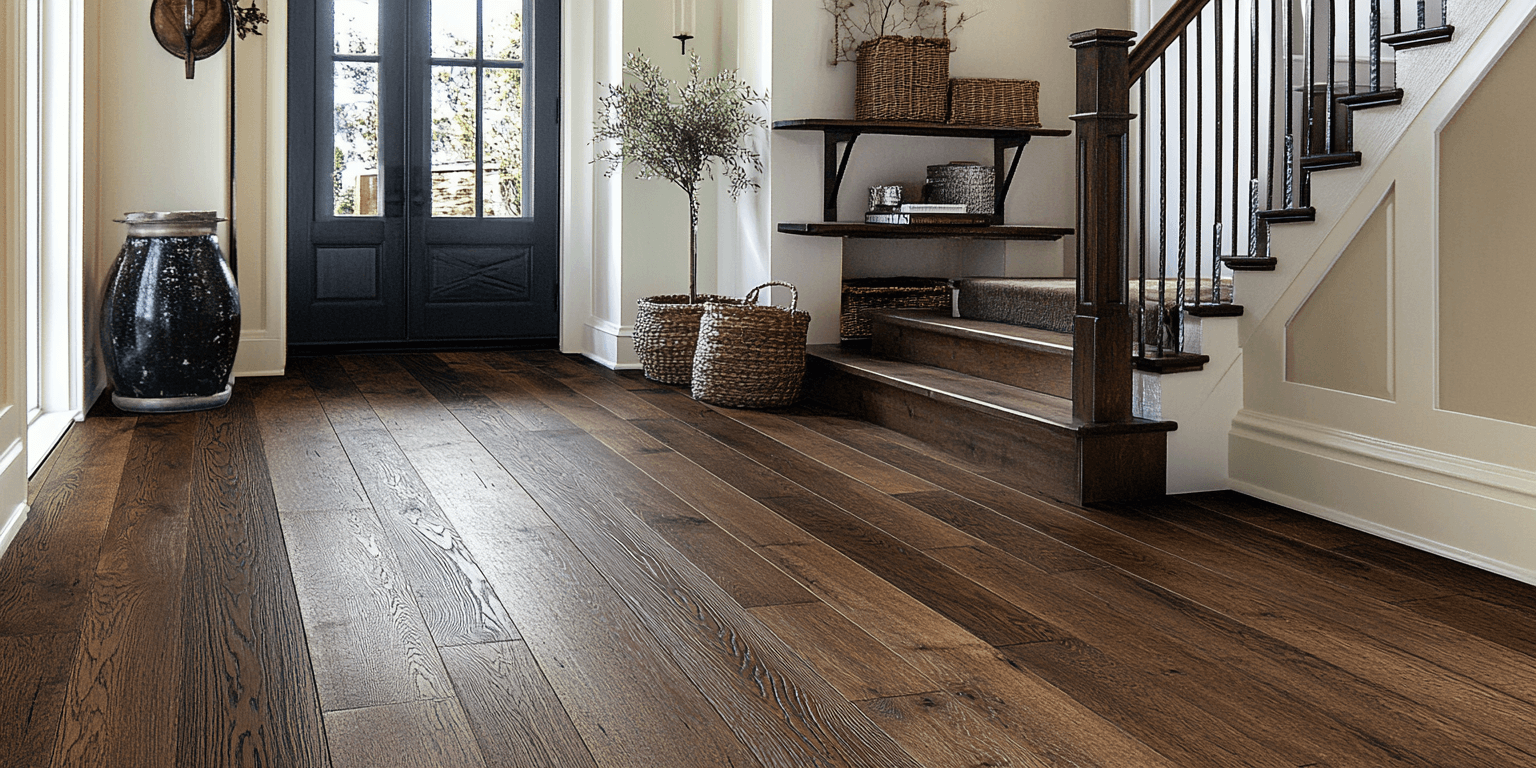Wood flooring has long been a staple in UK homes, offering timeless charm, warmth, and durability that few other materials can match. Whether you’re renovating a single room or giving your entire home a makeover, selecting the right type of wood flooring can feel overwhelming with so many options available. Factors like durability, budget, and the specific function of each room all play crucial roles in your decision-making process.
In this blog post, we’ll explore the different types of wood flooring, their pros and cons, and which options are best suited for your needs. We’ll also break down the costs of each type, so you can find a flooring solution that fits your budget without compromising on style.

Solid Wood Flooring
Solid wood flooring is made from a single piece of timber, typically around 18-20mm thick. It’s known for its durability and can be sanded and refinished multiple times, allowing it to last for decades with proper care.
Best For:
• Living rooms, dining rooms, and bedrooms, where foot traffic is moderate to low.
• Homes with stable humidity levels, as solid wood can expand and contract with changes in temperature and moisture.
Popular Types of Solid Wood:
Oak: The most popular choice in the UK, offering excellent durability and a classic grain. Available in red or white varieties.
Walnut: Rich in colour with deep, luxurious tones, perfect for adding warmth to any space.
Maple: A lighter option with a sleek, consistent grain, ideal for modern interiors.
Cost:
Solid wood flooring is typically the most expensive option, ranging from £60 to £120 per square metre, depending on the wood species and finish. Installation can also be costly, especially if you require professional fitting.
Pros:
• Long-lasting and can be refinished multiple times.
• Adds significant value to your home.
• Timeless and elegant appearance.
Cons:
• Prone to expansion and contraction with changes in humidity—not suitable for bathrooms or basements.
• Higher upfront cost for both materials and installation.

Engineered Wood Flooring
Engineered wood consists of a thin layer of real hardwood on top of several layers of plywood or high-density fibreboard (HDF). This layered construction makes it more stable than solid wood and better suited for areas with varying moisture levels.
Best For:
- • Kitchens, basements, and conservatories, where temperature and humidity fluctuations are common.
• Homes with underfloor heating, as engineered wood handles heat changes better than solid wood.
Popular Types of Engineered Wood:
Oak: The most common and versatile option, available in a wide range of finishes.
Hickory: Known for its rustic charm and high durability.
Ash: Light-coloured with a bold grain, perfect for Scandinavian-style interiors.
Cost:
Engineered wood flooring is generally more affordable than solid wood, ranging from £40 to £90 per square metre. Installation costs are typically lower, especially if you opt for a click-lock system that can be fitted as a floating floor.
Pros:
- • More resistant to moisture and temperature changes.
• Easier and cheaper to install than solid wood.
• Available in a wide range of styles and finishes.
Cons: - • Can only be sanded and refinished a limited number of times, depending on the thickness of the top layer.
• May not add as much value to your home as solid wood.

Laminate Flooring
Laminate flooring is a synthetic product made from high-density fibreboard, topped with a photographic layer that mimics the appearance of wood. A clear protective layer makes it highly resistant to scratches and moisture.
Best For:
- • High-traffic areas like hallways, entryways, and playrooms.
• Budget-conscious homeowners looking for a wood-like appearance without the high price tag.
Cost:
Laminate is one of the most budget-friendly options, costing between £10 to £30 per square metre. It’s also easy to install, making it a popular choice for DIY projects.
Pros:
- • Highly resistant to scratches, dents, and moisture.
• Affordable and widely available in various styles and finishes.
• Easy to install with click-lock systems.
Cons:
• Doesn’t have the same natural feel or warmth as real wood.
• Cannot be sanded or refinished—once damaged, it must be replaced.
• May not add as much value to your home.

Bamboo Flooring
Though technically a grass, bamboo is often grouped with hardwood flooring due to its similar look and feel. It’s a sustainable option that grows much faster than traditional hardwood trees.
Best For:
• Eco-conscious homeowners looking for sustainable, environmentally friendly materials.
• Modern interiors due to its sleek, contemporary appearance.
Cost:
Bamboo flooring typically ranges from £30 to £70 per square metre, making it comparable in price to engineered wood.
Pros:
• Eco-friendly and sustainable.
• Highly durable, especially strand-woven bamboo, which is harder than many traditional hardwoods.
• Naturally resistant to moisture and insects.
Cons:
• Quality can vary significantly; cheaper options may scratch easily.
• Sensitive to extreme changes in humidity if not properly sealed.

Cork Flooring
Cork flooring is made from the bark of the cork oak tree and is known for its soft, cushioned feel underfoot. It provides a unique, natural aesthetic while offering comfort and functionality.
Best For:
• Home offices, bedrooms, or kitchens, where you spend a lot of time standing.
• Soundproofing needs, as cork has natural acoustic properties.
Cost:
Cork flooring generally costs between £25 to £60 per square metre, depending on quality and finish.
Pros:
• Soft and warm underfoot, reducing strain on joints.
• Naturally antimicrobial and resistant to mould and mildew.
• Excellent for sound insulation.
Cons:
• Can dent easily under heavy furniture.
• Requires regular sealing to protect against moisture and wear.
• Fades over time with exposure to sunlight.
Choosing the Right Flooring for Your Space
High-Traffic Areas (Hallways, Entryways):
Laminate or engineered wood are durable, scratch-resistant choices that can handle heavy use.
Moisture-Prone Areas (Kitchens, Basements, Bathrooms):
Engineered wood, bamboo, or cork are better suited for fluctuating humidity levels.
Living Rooms and Bedrooms:
Solid wood offers timeless beauty and increases home value, while engineered wood provides a more affordable, stable option.
Budget-Friendly Options:
Laminate delivers a wood-like appearance at a fraction of the cost, while engineered wood offers real wood finishes without breaking the bank.
Wood flooring offers an unparalleled blend of beauty, warmth, and functionality. Whether you prefer the classic elegance of solid wood, the practical durability of engineered wood, or the affordability of laminate, there’s an option for every home.
By understanding the different types of wood flooring, their unique characteristics, and their costs, you can make an informed decision that not only enhances your home’s aesthetic but also suits your lifestyle and budget.
At aIDyl, we’re here to guide you every step of the way on your design journey. Did you know we can create stunning home designs for clients anywhere in the world? Whether you’re in the USA, Australia, or the UK, aIDyl can transform your vision into an affordable, beautiful reality. Take a look at our packages and get in touch with us now to start designing the space of your dreams!
If you’re looking to craft a space that seamlessly blends texture, colour, and functionality, explore our budget-friendly interior design services at aIDyl. Let’s bring your home to life with style, personality, and elegance! Book your free discovery call now.


